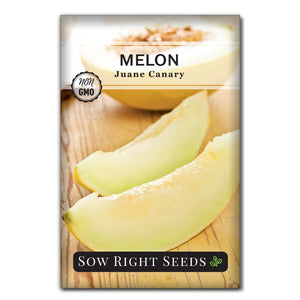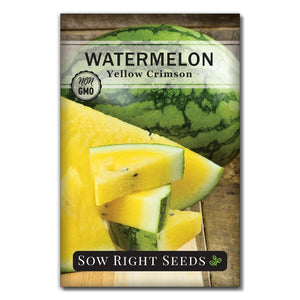How to Grow the Sweetest, Full-Flavor Cantaloupe and Honeydew Melons
MelonsIf you’ve ever experienced the perfection of a homegrown vine-ripened melon, you know nothing else compares. Unfortunately, many people don’t know what cantaloupes and honeydew melons should taste like.

A perfectly ripe cantaloupe has no comparison. It has a sugary sweetness that is hard to describe. It tastes like sugar, but it’s not overly sweet. The flesh of a melon should be firm but soft as the juices melt in your mouth. If this is the goal of your homegrown melons, read on for the planting and growing tips that will give you a sweet harvest of cantaloupe and honeydew melons.

Cantaloupe and Honeydew Melons
It may not be surprising to learn that humans have been enjoying melons for over 4,000 years. These sweet and delicious fruits are always worth growing to guarantee the best flavor.
There are two main melon genera. Watermelon falls under the Citrullus genus, and honeydew and cantaloupe are in the Cucumis genus. Our watermelon growing guide has all the tips you need for growing and harvesting juicy melons. This guide will focus on honeydew and cantaloupe.
How to Grow Cantaloupe from Seed
Growing cantaloupe from seed is easy and straightforward. You can start melon seeds indoors or directly sow.
Plant seeds when all danger of frost has passed. Sow melon seeds directly into soil that's at least 70°F. Plant 3 to 5 seeds 2 inches apart and thin to the two most vigorous plants once the melon seedlings have true leaves.
In cooler climates, you can start seeds indoors 2-4 weeks before transplanting outdoors to get a head start on the growing season.

Cantaloupe Seed Germination Tips
-
Melon seeds germinate best in warm soil. If starting seeds indoors, use a heat mat to keep the soil temperature between 70 and 80ºF.
-
If direct sowing melon seeds, wait until the soil warms up to 70ºF. Dark plastic can warm up the soil.
-
Plant melon seeds 1/2 to 1 inch deep, depending on the seed size. Larger seeds can be planted deeper. Check the seed packet for your particular melon variety.
-
Seeds need to stay moist until they germinate. Depending on the melon variety, it could take 5 to 14 days for seeds to germinate.
Once melon seeds have germinated, they need bright light. For indoor seedlings, place a grow light a few inches above.

Transplanting Cantaloupe Seedlings
Cantaloupe seeds started indoors need to be transplanted outside before they become rootbound and after all danger of frost has passed. Take the time to harden off seedlings before transplanting. Do not disturb tender roots when transplanting.
Melon seedlings can be thinned to 2 or 3 plants per hill.
Allow plenty of room for vines to spread. Space seedlings 36 to 60 inches apart, depending on the variety. Some melon plants need more room to grow.

How to Grow Cantaloupe and Honeydew Melons
Once the seeds have started growing, the next step is maintaining the melon plants with the crucial nutrients, water, and sunlight they need for excellent fruit development.
Soil
Cantaloupes and honeydew melons thrive in fertile, well-draining soil that is slightly acidic. Before planting, you can amend your soil with well-rotted compost and a balanced slow-release fertilizer.
Sun
A location with full sun is best for growing melons. While they love the sunlight and warmth, they can get too hot. When temperatures rise above 90ºF, melon plants appreciate some shade.
Water
Melons are 90% water, so make sure you water them well. Melon plants need at least 1 inch of water a week. When fruits start developing on the vines, increase the watering to 2 inches per week. Avoid overhead watering, as it can lead to mildew. Drip irrigation is an efficient way to water your melon plants. Mulch can help conserve moisture and keep weeds out.
Fertilizer
Test your soil before adding fertilizer. Too much nitrogen will result in more leaf production and less fruit. An all-purpose fertilizer such as a 5-5-5 can be added before planting. You can also top dress with compost when the fruit starts setting.
Temperature
Melons are a warm weather crop and will thrive in temperatures between 65 and 95ºF. Use mulch to conserve water and moderate the soil temperature.

Special Melon Growing Tips
These helpful tips can increase your success in growing melons.
-
Intercropping and Companion Planting
The diversity of crops in a home garden can be beneficial for increasing crop yields and minimizing pests and diseases. Plant flowers along with your melons to attract more pollinators. Intercropping and companion planting will result in better blossom pollination. Companion plants can also help deter pests.
-
Storage and Eating
For the best flavor, eat melons at room temperature. Melons that are stored too long will lose their flavor and color.
-
Weeding
Melons have a shallow root system, so don’t make them compete with weeds. Once they have lots of big leaves, they will be more capable of shading out weeds.
-
Pollination
Bees are necessary to pollinate the flowers. Male flowers come on first and will fall off, and that’s normal. The female flowers will have a small fruit just behind the blossom. Once these female flowers are pollinated, they will mature into a melon.
Solutions for Melon Pests and Diseases
There are common pests and diseases that can be mitigated so that they don’t destroy your whole melon crop.
Cucumber beetles and aphids are two common melon pests.
With efficient watering and good garden hygiene, diseases such as Powdery mildew, Alternaria leaf spot, anthracnose, downy mildew, and Mosaic virus can be diminished.
Crop rotation can also play a helpful role. Don’t plant melons where you had cucumbers or squash the year before.

When to Harvest Cantaloupe and Honeydew Melons
Knowing when and how to harvest is the key to juicy, sweet melons. These expert gardening tips will help ensure the best melon harvest.
Three weeks before harvesting melons, cut back on watering for a sweeter melon taste.
Don’t water melons at all the day before harvesting. This keeps the flavor intense instead of watered down.
Cantaloupes are ripe when the green stem turns tan-yellow between the veins. When they are ripe, you can easily snap the stem from the melon.
Each variety of melon has its own color that indicates ripeness. Honeydew will turn slightly more yellow and less green, but too much yellow, and it’s past its prime.
Cantaloupe FAQs
Can you trellis cantaloupe and honeydew melons?
Trellising is an excellent way to save space when growing melons. Cattle panels are sturdy and work well to hold up the vines. Additionally, you will need something to hold the melons so they don’t break off when they get heavy. Nylon stockings are popular because they stretch as the melons grow and are sturdy enough to hold the weight.
How to tell when a cantaloupe is ripe?
Each melon variety will be a different color, but most melon stems will start to turn brown. Cantaloupe stems will easily “slip” off the vine as they dry out. Some gardeners can tell when a melon is ripe by its sweet smell. This is easier to do with muskmelon varieties.
How can I avoid a grainy texture in melons?
Sometimes, the texture is off, and the melon feels grainy instead of smooth. A grainy or sandy texture develops when a melon is overripe. Pick and eat melons before they have overripened.
My melon has no flavor. What happened?
The worst thing is to bite into a melon you’ve grown all season, only to discover it doesn't have that distinctive sweet flavor you’ve been waiting for. When melons get too much water before they are harvested, it weakens their flavor. To keep the melon flavor concentrated, limit water a few weeks before harvesting and stop watering one week before.
When is the best time to plant cantaloupe?
The best time to plant melons is when it is warm enough for them to grow and enough time for them to develop before the weather gets cold. Melons are a warm-weather crop, and cold weather will keep them from growing.
How long does it take for cantaloupe to grow?
Some cantaloupe varieties take as few as 80 days to grow. Others will take a few more weeks.
You’ll love the flavor of homegrown melons. For the sweetest taste, try planting the tried-and-true heirloom varieties. Then, follow these melon-growing tips for a successful harvest.








Leave a comment